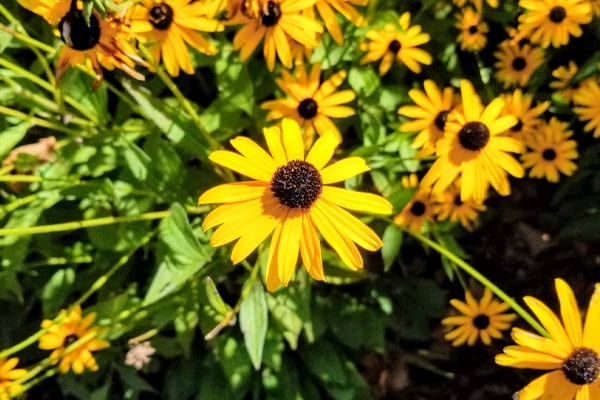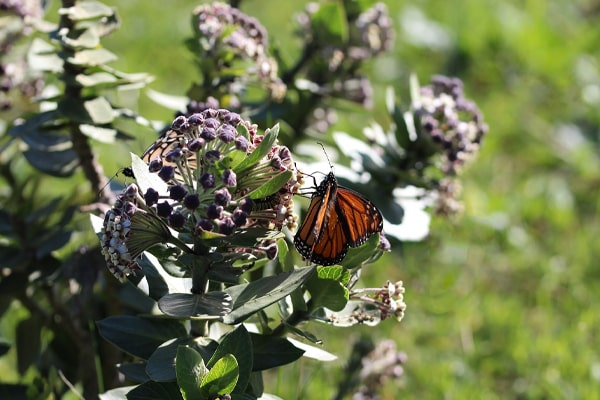Native plants support the web of life in nature by providing food, homes, and essential connections between different species. They are well adapted to local environmental conditions, making them more resilient to pests, diseases, and extreme weather events. This resilience can help stabilize ecosystems and reduce the need for chemical inputs, such as pesticides and fertilizers.
By caring for native plants, we’re helping to keep our environment healthy and balanced, which is good for everyone – plants, animals, and people alike.
Contents []
Why Native Plants Matter in Promoting Biodiversity
Native plants, specifically those that naturally grow in a particular area, have been around for a long time and are significant in keeping a specific region’s ecosystem healthy.
One key reason why native plants matter is their role in supporting biodiversity. In nature, plants play a central role in maintaining balance in a whole ecosystem.
And each has a role in maintaining this balance. Plants provide food, homes, and places for many different animals. Birds, insects, and small mammals rely on native plants to survive and thrive.
Native plants are also important because they’ve grown up with the insects in their area. They’ve formed unique relationships.
For example, some butterflies lay their eggs on specific native plants, and their caterpillars eat only the leaves of those plants. This kind of close connection between plants and insects is how life keeps going.
Native plants also attract and support pollinators. Pollinators, like bees and butterflies, visit native flowers to get nectar. As they collect nectar, they move pollen around, helping plants make fruits and seeds. This process is like a natural cycle that keeps many species alive.
Another amazing thing about native plants? They are tough and can handle the local weather and bugs.
Native plants have adapted to their environment over time, making them strong and resistant to weather changes or pest problems. This helps keep the ecosystem stable and able to deal with challenges like extreme weather or new plants that don’t belong there.
Using Native Plants to Boost a Garden’s Resilience

Using native plants is a practical way to support your local ecosystem. By incorporating them into your garden and participating in community efforts, you contribute positively to the environment, creating a harmonious balance between plants, animals, and people. Here are ways to use native plants to boost the garden‘s health:
Learn about local plants: Start by discovering the plants native to your region. Visit local parks, and nature centers, or talk to experts to find out which plants naturally belong in your area. Understanding native plants helps you make informed choices.
You can also join or support local community projects focused on restoring native vegetation to know more about local plants in your region and how to grow them. These initiatives often involve planting native species in public spaces or natural areas, contributing to the environment’s overall health.
Grow native plants for your garden: After learning about the many native plants you can grow in your garden, start picking the ones that will suit your garden the best.
When planning a garden or adding plants to your yard, opt for native species. These plants are well-suited to the local climate, making them easier to care for and more likely to support local wildlife.
Conserve Water: Native plants are adapted to local weather conditions and often require less water than non-native species. This makes them an eco-friendly choice, contributing to water conservation efforts in your community.
Support Pollinators: Native plants often have flowers that attract local pollinators, like bees, birds, and butterflies. Having these plants in your garden provides a food source for these essential insects. This helps support pollination, benefiting both plants and wildlife.
Find out which native plants attract pollinators. Usually, flowering plants and fruit-bearing plants attract the most pollinators because they provide food for garden critters. Trees and bushes, on the other hand, provide shelter for pollinators, particularly birds.
Use Local Mulch: When mulching your garden, consider using mulch made from local materials. This helps recreate a natural environment and supports the growth of native plants. It also reduces the risk of introducing non-local plants or pests.
You can also use landscape fabric as an alternative to mulch. Landscape fabric helps control weeds from growing and absorb moisture in the soil.
Avoid Invasive Plants: Be cautious about introducing non-native plants that might become invasive. These plants can outcompete native species and disrupt the balance of the local ecosystem. Stick to plants that naturally belong in your area.
Create Habitat Spaces: Arrange native plants in your garden to create diverse habitats. Different plants offer various shelters and food sources for insects, birds, and small animals. This diversity attracts a range of wildlife, making your garden a mini-ecosystem.
A birdhouse, a butterfly feeder, a nut dispenser for small animals, and growing native plants are sure-fire ways to make your garden a virtual paradise for the local wildlife.
Tips: Growing Native Plants in the Garden

- Native plants have preferences for where they like to live. Place them in areas with the right amount of sunlight and soil type. Some might prefer sunny spots, while others thrive in shade.
- Once established, many native plants are well-suited to local rainfall patterns. During the early stages, water them regularly to help them establish roots. Afterward, let them rely more on natural rainfall.
- Apply a layer of mulch around the base of your native plants. Mulch helps retain moisture, suppress weeds, and regulate soil temperature, creating a favorable environment for growth.
- Arrange native plants in groups rather than scattering them. This mimics their natural growth patterns and enhances the visual appeal of your garden. It also attracts specific local wildlife.
- Native plants are generally adapted to local soil conditions and may not need much additional fertilizer. Excessive fertilizer can harm their natural balance, so use it sparingly, if at all.
- Native plants often have specific shapes and growth patterns. Prune them carefully, if needed, to maintain their natural form. Avoid excessive pruning, as it can disrupt the plant’s ability to thrive.
- Native plants are excellent for attracting local wildlife. Let some plants go to seed and provide habitat for insects and birds. This creates a vibrant ecosystem in your own backyard.
- Be patient! Native plants might take a bit longer to establish themselves compared to non-natives, but they’re worth the wait. Be patient and allow them the time they need to grow strong and healthy.
- Once your native plants are well-established, consider sharing seeds or cuttings with friends and neighbors. This helps spread the benefits of native plants and contributes to the overall health of your community’s green spaces.
Growing native plants has many benefits for the garden and beyond. These plants also create a harmonious balance between plants, animals, and people. Using native plants in your area can be a simple yet powerful way to help the local ecosystem thrive.



